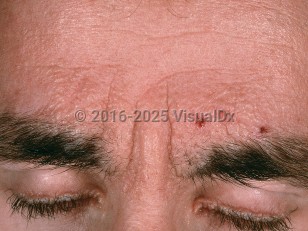Lipoid proteinosis in Adult
Alerts and Notices
Important News & Links
Synopsis

Lipoid proteinosis (LP), also known as Urbach-Wiethe disease or hyalinosis cutis et mucosae, is a rare autosomal recessive disorder due to a loss-of-function mutation of the gene coding for the extracellular matrix protein 1 (ECM1). Mutations in ECM1 are thought to cause extensive deposition of noncollagenous proteins and glycoproteins in the skin, oral mucosa, larynx, and brain. Individuals of European ancestry are most often affected; there is no sex predilection.
The disorder presents early in life and is slowly progressive. The first clinical sign is often a weak cry or hoarseness as a result of accumulation of hyaline-like material into the laryngeal mucosa, with the hoarseness persisting throughout life. Skin changes consisting of vesicles and hemorrhagic crusts on the face and extremities with resultant scarring generally appear during the first 2 years of life. Subsequent skin changes include the formation of infiltrated papules, plaques, and nodules on the face, axillae, and scrotum with verrucous lesions on the elbows, hands, and knees. There can be diffuse infiltration of the tongue, frenulum, and oropharynx along with dental anomalies. Neurologic manifestations include behavioral or learning difficulties and seizures. Mortality is usually related to laryngeal obstruction in infancy or to associated epilepsy.
The disorder presents early in life and is slowly progressive. The first clinical sign is often a weak cry or hoarseness as a result of accumulation of hyaline-like material into the laryngeal mucosa, with the hoarseness persisting throughout life. Skin changes consisting of vesicles and hemorrhagic crusts on the face and extremities with resultant scarring generally appear during the first 2 years of life. Subsequent skin changes include the formation of infiltrated papules, plaques, and nodules on the face, axillae, and scrotum with verrucous lesions on the elbows, hands, and knees. There can be diffuse infiltration of the tongue, frenulum, and oropharynx along with dental anomalies. Neurologic manifestations include behavioral or learning difficulties and seizures. Mortality is usually related to laryngeal obstruction in infancy or to associated epilepsy.
Codes
ICD10CM:
E78.89 – Other lipoprotein metabolism disorders
SNOMEDCT:
38692000 – Lipid proteinosis
E78.89 – Other lipoprotein metabolism disorders
SNOMEDCT:
38692000 – Lipid proteinosis
Look For
Subscription Required
Diagnostic Pearls
Subscription Required
Differential Diagnosis & Pitfalls

To perform a comparison, select diagnoses from the classic differential
Subscription Required
Best Tests
Subscription Required
Management Pearls
Subscription Required
Therapy
Subscription Required
References
Subscription Required
Last Reviewed:08/25/2025
Last Updated:08/26/2025
Last Updated:08/26/2025
Lipoid proteinosis in Adult

